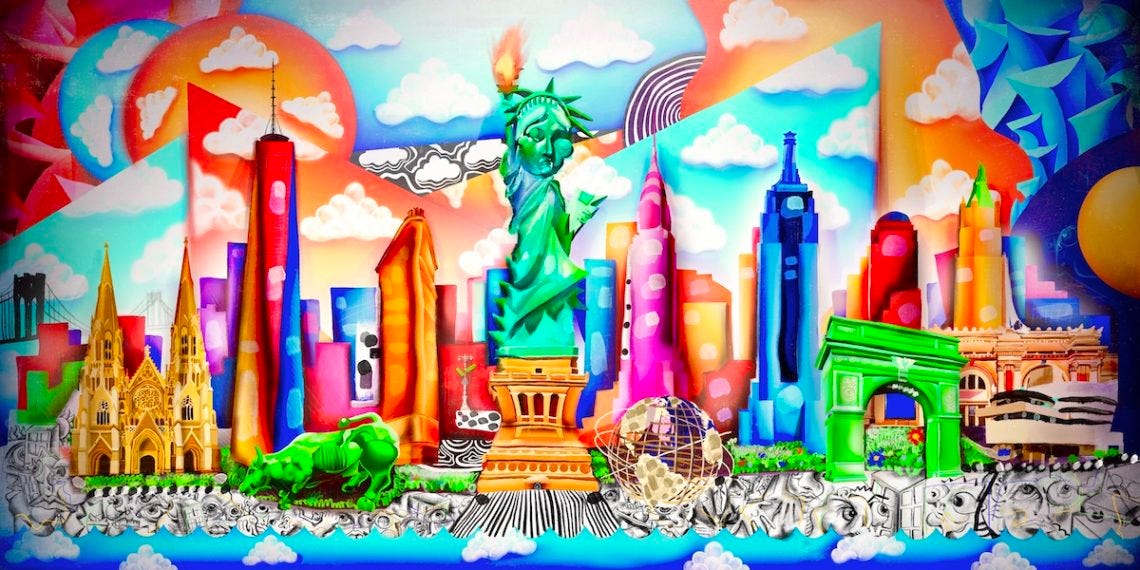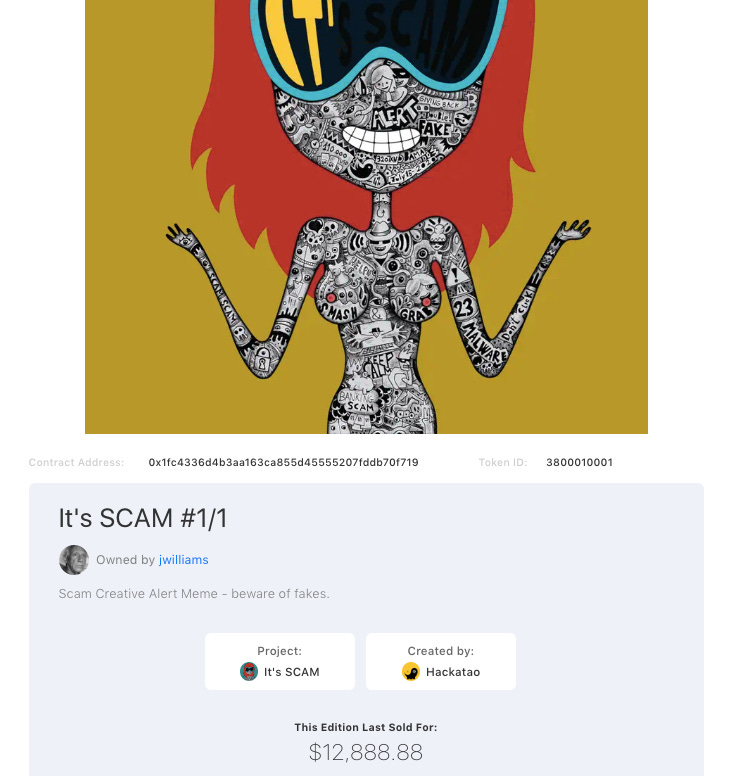Under The Radar - Interview with Kevin Pujol on NFTs
Discussing NFTs in some detail and the future of digital art
Hey everyone,
Today I’m putting out a quick interview with Kevin Pujol we did earlier this month.
Kevin runs Magma, a firm tracking trends and opportunities to give you insights and opportunities to capitalise on. They have a focus on the French market at the moment and do a weekly newsletter as well as host a private community to interact with their team, other entrepreneurs and leaders. If you are interested to learn more you can HERE.
Below we discuss a little bit about NFTs and their importance going forward 👇
For those who don’t know, can you briefly explain what non-fungible tokens (NFTs) are and why they are important?
NFT are digital assets that can take many different forms : digital art or drawings, virtual trading cards, skins or weapons used in video games...
Non-fungible means each one of them is unique and has a singular identity as opposed to fungible goods (like currency) which have no singular existence and are interchangeable (one dollar is similar to another).
According to non-fungible.com, a website tracking every NFT sales, the total volume of NFT sales has reached $161.5 million, ~$12.8 million in the last 30 days.
How do NFTs link to crypto?
NFTs have a certain value because they are produced in limited quantities and cannot be reproduced.
What guarantees their unicity is blockchain, the same technology used by bitcoin to secure the mining process.
NFTs are often called crypto collectibles. Just like bitcoin, they do not need a central authority to guarantee their value, blockchain is certifying the authenticity.
How might NFTs hasten the arrival of ‘The Sovereign Individual’?
I guess you’re referring to the book of James Dale Davidson (which I haven’t read but it’s on my list !). From what I understand, he’s saying we’re gonna witness a weakening of the Nation State and a transfer of some more power to the individuals.
This is the main idea about blockchain, it helps build decentralized networks with no central institution to guarantee the safety of systems. Blockchain is both a threat and a potential competitor to states because it helps to build decentralized networks, which by definition, doesn’t need a central authority to ensure regulation.
NFT value is not protected by any institution, It can be exchanged peer-to-peer and, as long as you trust the blockchain system, the value is guaranteed. Every technology that helps to build P2P systems empowers the individuals.
ROB: Going back to Naval’s tweet below…:

Can you speak more on how sports associations and gaming companies are leveraging this new tech to reinvent memorabilia and digital items?
With coronavirus, professional sports teams revenue is in free-fall (ticketing, in stadium revenue and television rights are at an all-time low). To compensate that, I really believe that NFT could be a big bet for them. They can monetise their image selling digital cards.
Sorare, a french startup launched in 2018, is already offering that option. It’s a kind of fantasy football game, where anyone can buy, sell and manage a virtual team with digital player cards.
Each card is more or less rare, defining its value (think about when we were trading Pokemon cards as kids but in a virtual way). The game is using blockchain technology based on the Etherum to guarantee the value of each card. The total transaction value on the platform has reached $7 million (according to nonfungible.com)
Great video in English on some of the platform economics is provided below:
PSG, the leading french football club, announced in September, a partnership with Sorare. 100 clubs are now on Sorare, and more should come. This model could be easily duplicated to other sports, even musicians could sell digital cards to their fandom.
Who are some of the pioneering artists or creators in the space using NFTs and can you provide some case studies or examples of NFTs being used for smaller creators?
In October, I saw that the auction house Christie’s sold their first NFT for more than $130 000 (X7 high estimate). It’s a digital portrait of a bitcoin that Robert Alice, the artist, called Block 21. Another artist called Beeple has raised $3.5 million selling blockchain backed digital art.
Part of a 40-piece work, “Block 21” combined physical art—disks engraved with Satoshi Nakamoto’s original code for Bitcoin—with an integral NFT work which depicts Block 21 changing from day to night depending on the physical version’s location and time zone.
I’m pretty sure this is only the beginning.
Anthony Pompliano, said in a recent podcast “I personally believe that the digital art market cap will grow to become larger than the physical art market cap”, do you agree with his view?
I don’t believe there will be such a strong opposition between the two. I think that barriers between digital and physical art forms will slowly fall and we will expect artists to do both.

ROB: Readers, if you want to go to Anthony’s original article (‘The Next Big Bet - Digital Art’) which discusses his thesis, it is HERE.
Of note, NFT art sales hit $8.2 million in December 2020.
EDM star Deadmau5 partnered with digital artist Michah Dowbak — aka Mad Dog Jones — to release two NFT art collections on Nifty Gateway (shows celebrity interest developing). As of Coin Telegraph’s reporting a few days ago, they had raised $330,000 with the final auction still yet to finish.
And there’s an excellent section below from Anthony’s article where he lays out the case (all his words). The sizes of the markets are of course radically different at the moment, physical art is ~ $60 billion and digital/NFT art is $12 million or so but the general idea is that we are at a very early stage with the latter (0.02% of the size) AND the product might end up having superior economics/features. Plus it already has celebrity (e.g. Deadmau5) and smart money (Winklevoss twins - Nifty Gateway) interest.
But Kevin argues the differentiation between the two won’t be so strong, they will merge over time.
A traditional piece of art is static and sits on a wall. There is no motion. The art does not change unless someone takes the art off the wall and hangs a different piece. Physical art is hard to move around the world, it can be easily damaged, and there is difficulty in proving what is authentic and what is not.
Digital art is the next evolution of art. Each piece can incorporate complex movement and motion into the art. A single screen on a wall can periodically cycle through different pieces of art at the predetermined direction of the homeowner or art collector. The digital art can be sent to anyone in the world with a few clicks of a button, it is immune from damage, and authenticity and provenance is transparently available for anyone to verify. Quite literally, digital art has significant advantages over traditional art in the same way that digital news has advantages over physical newspapers.
Talking security, what are the current and future risks with malicious attackers pivoting towards NFT wallets and targeting high ticket digital items?
This is definitely an important issue not just for NFT but for every system powered by blockchain (like bitcoins). I personally think that it’s safe enough, and the risk is as high as getting your paintings robbed at home. Probably we will see some insurance for NFT covering potential hacks in the future.
The biggest threat to blockchain safety could be quantum computers. Some experts have written that with super powerful computers you could potentially break blockchains. But thankfully quantum computers are not mass produced yet and we should have time to figure out quantum safe blockchain by the time they are.
If readers want an investment play in the space right now, do you have any recommendations or tips for them?
Definitely check nonfungible.com to get familiar with the ecosystem. Reddit is a wonderful source of information as well. I follow r/etherum, members are often talking about NFT here or there. You can check as well r/nft.
NFT are still a very new asset and you should invest very cautiously.
ROB: The approach Anthony (Pompliano) and Morgan Creek Digital Assets have taken is partnering with digital artists themselves to commission work from them (he ordered 6 initial pieces from Fewocious) and then they auction them off or hold on to them and let them appreciate.
In addition to the FEWOCIOUS collection and other private commissions, we have been busy participating in various digital art auctions. We are not ready to showcase everything we have done yet, but here are a few highlights:
The 1 of 1 Hackatao piece that sold for more than $12,000 (link)
The #9 of 25 Trevor Jones Bronze Bitcoin Bull (link)
We lost the bidding war for Trevor Jones’ 1 of 1 Bitcoin Bull, which was ultimately purchased for $55,555. We immediately purchased the original painting that the NFT is based on for $55,000 directly from the artist.
Any other thoughts or points you’d like to share about NFTs and some thoughts on the future?
I’m really excited to see how NFT are gonna evolve in the future. The concept of NFT is really questioning the deep meaning of value. Can we give value to something that is not physically real, that we cannot touch ? I think the answer is yes. As long as it’s unique or cannot be reproduced easily, it’s valuable.







